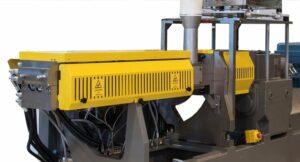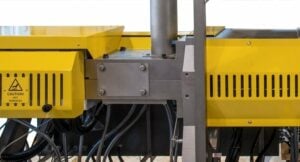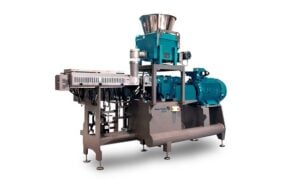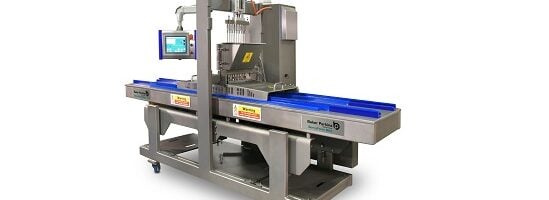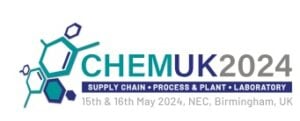Breakthrough technology available on all Baker Perkins powder coating twin-screw extruders delivers a step change in output while also improving quality and reducing running costs.
Baker Perkins’ patented MAX³ feed system delivers a 40% to 100% increase in throughput, and combines this with a top feeding arrangement that significantly reduces cost-of-ownership.
The key to the improved throughput is the design of the infeed port. This has been carefully sculpted to feed the material uninterrupted around the feed screws and into the barrel while allowing entrained air to escape. The improved flow characteristics enable throughput to be increased significantly on all types of material – and are particularly effective on low density powders and fines.
Measurable advantages over side-feeding
The result is that there are no longer any applications where side feeding necessary. It has long been known in the industry that forcing the material into the feed screws with a side feeder leads to high wear, poor quality and slow changeover and top feeding has always been the preferred option for that reason. The patented features of MAX³ mean that top feeding may be used for every type of material and application.
Top feeding has natural advantages over side feeding: the infeed port is larger, as the width of the barrel is greater than its height. The only pressure needed to feed the material is gravity. By contrast, side feeders are forcing the material through a narrower aperture under pressure, generating excess heat in the infeed. This causes pre-melting of resin on the screws, reducing conveying capacity and leading to poor quality. High pressure leads also to high wear and increased maintenance costs for both extruder and feeder.
With side feeding, the main drive and feeder speeds must be precisely matched to avoid over-feeding, which causes excessive wear on the barrel liners, screw elements and feeder. Achieving precise synchronisation is difficult as there is very little detectable difference between a machine that is correctly set up and one that is overfeeding. Top-fed machines are much more tolerant as the operator can see at a glance when the optimum feed rate is being achieved.
The ability to use top-feeding means that MAX³ also contributes to easier cleaning and faster changeovers. Access to the clamshell barrel is gained simply by removing the feed chute and leaving the feeder in place, whereas a side-feeder and its refill system have to be physically disconnected and moved.
Results at customers’ sites show the MAX³ reliably leads to throughput increases between 40 and 100%, depending on formula. When retrofitted to existing machines as part of a process optimization programme results have been even more spectacular, with increases between 175% and 275% achieved.
The key development that has made these increases possible is designing the MAX³ infeed port to work in harmony with a top feeder and the intake screws to ensure a smooth and even flow of material into the extruder. The patented design significantly increases output across the full range of materials, especially lightweight ones that have traditionally been side fed, as well as increasing quality, improving process stability and reducing ownership costs.
